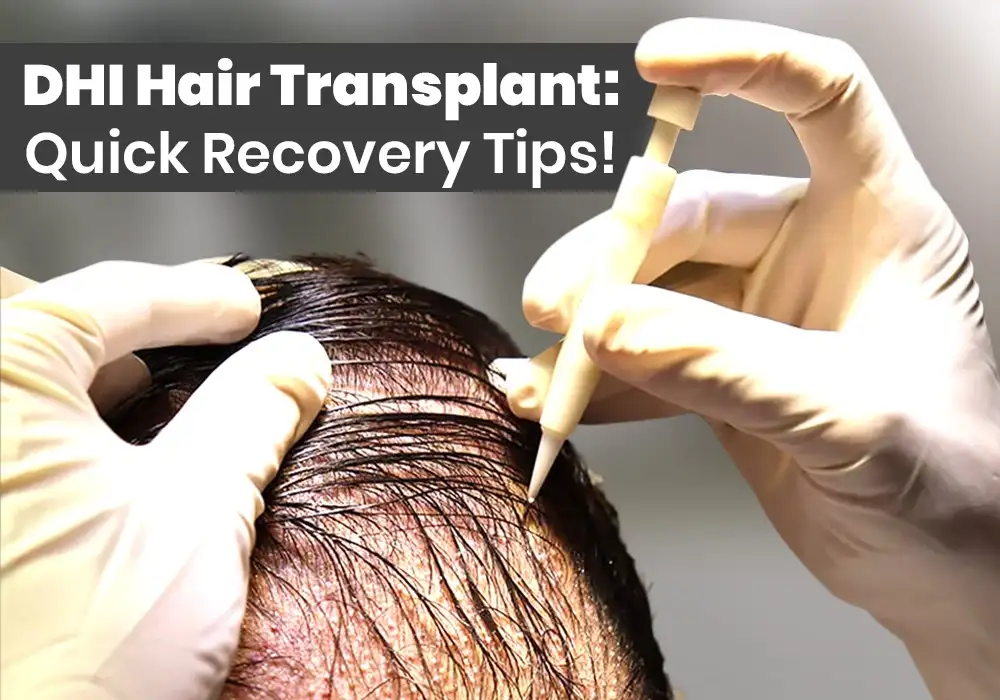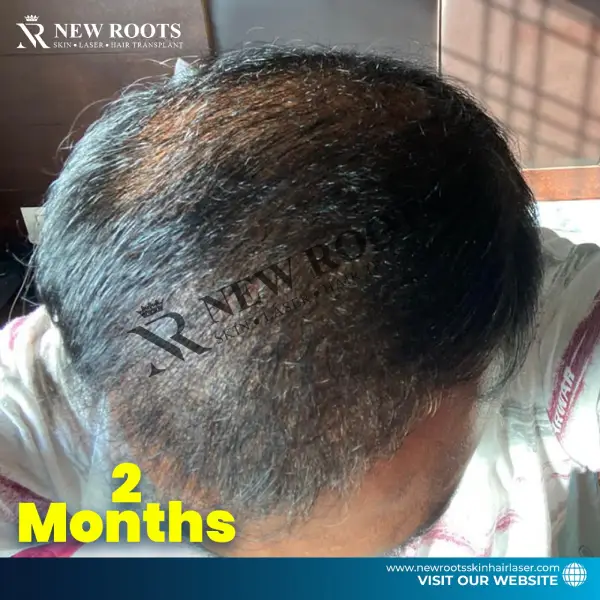Introduction
Another factor the patient needs to consider is DHI hair transplant recovery time. This revolutionary method of hair transplant offers the beauty of growth without the horror of a scar because it heals fast.
After the first few days of surgery, patients might witness little swelling and redness, which is common after surgery.
These effects usually only last up to 72 hours after the operation. Still, during a person’s recovery, it is crucial to adhere to post-operative procedures as recommended by the professional staff.
In the second week of recovery, the first layer of scabbing will peel off, showing that the body is healing and adapting to the newly implanted hair follicles.
Regardless of the differences in personal experiences, most clients can return to their daily activities within two to three weeks of the procedure. By this time, any redness or swelling will have subsided, thus allowing the patient to appreciate the natural look of their DHI hair transplant.
Table of Contents
What is a DHI Hair Transplant?
DHI refers to Direct Hair Implantation, a relatively new, safe, and efficient method of hair transplant surgery.
Compared to other techniques, DHI uses a micro-screw technique to collect hair follicles and transplant them one at a time into the recipient site using a Choi pen.
It places the grafts accurately, looks most natural, and does not leave much scar tissue behind.
The advantages of DHI hair transplant
Minimize Scarring: Minimal scarring occurs when using DHI since implantation is very selective.
Natural Results: One of the most attractive features of the implantation technique is that the patterns of the subjects’ hair growth are preserved.
Reduced Downtime: As for the recovery period, DHI is known to be faster than the other techniques.
This list reveals the average DHI Hair Transplant recovery time after surgery:
- Initial Recovery Phase
Generally, the first phase of recovery from a DHI Hair Transplant lasts approximately 7 to 10 days. After the treatment, one might feel slight inflammation of the skin of the treated area, redness, and slight pain.
However, these symptoms should be minimized, and a proper recovery course should be followed according to the surgeon’s advice regarding postoperative care.
- Shedding Phase
After the second to fourth week, if there is no hair on the scalp, you may observe the new hair that has been transplanted to the shed. Shedding hair is normal after a hair transplant and happens as a part of the shock loss that most patients experience.
Shedding after hair transplant surgery is normal and should not raise the alarm. Because shedding is temporary, new hair will gradually begin to grow back.
- New Hair Growth
The development of new hair often occurs from the third to the fourth month after the sessions start. Three to six months after the procedure, the patient will begin to notice some regrowth at the hairline; thus, in the next 12 to 18 months, the thickness of the hair will come in ultimately.
DHI Hair Transplant Recovery Time: Ways to fasten the process of healing
Rehabilitation after DHI hair transplant recovery time operation is the other essential stage that determines the outcome of the hair transplant. It is crucial to know the timeline of recovery and follow the aftercare advice since they play a critical role in boosting the outcomes and magnifying the rate at which skin heals.
DHI Hair Transplant Recovery Process :
The recovery rate after the DHI hair transplant depends on the person’s state of health, the level of the intervention, and the adherence to post-surgical measures.
However, most patients can expect the following stages of recovery.
Initial 72 Hours
The DHI treatment is very gentle. Within the first few days after the treatment, patients may notice that their faces and lips are slightly swollen and red—this is quite normal—these effects generally only last for the first seventy-two hours after administration.
Second Week
In the second week of treatment, patients may observe that the scabbing that has occurred initially begins to shed—this is a positive sign of the wound healing process and also of the body’s adaptation to the new hair follicles that have been grafted.
Stair climbing has been recommended; however, no directly related-pressure exercises, including swimming and receiving the sun tan, should be carried out.
2-3 Weeks
Typically within two to three weeks after the surgery, the patient is largely ready to return to general activities because most instances of redness and swelling should have reduced, and the smiles of having natural-looking hair through the DHI hair transplant will be smile-worthy.
Dhi Hair Transplant Recovery Time Female
The issue concerning the recovery process after the Direct Hair Implantation (DHI) hair transplant is relevant, specifically for female candidates.
Nonetheless, the overall timing and the principal stages are comparable to those observed in male patients, but several peculiarities of female identity should be discussed separately.
Special Concerns for the Female Patients
Hormonal Factors:
The post-operation recuperation times could be relatively different in women and men because of hormonal changes that are more prominent in former patients, impacting healing and new hair growth.
Hair Styling Considerations:
Women should perhaps be more careful with the style that they choose for their hair and the products that they use on their hair, especially in the first one or two weeks after the surgery.
Cosmetic Concerns:
Depending on the result of the hair transplant surgery, some female patients may be worried about signs of healing, such as scab formation and the first sign of shedding, and may need the help of a hair transplant surgeon.
Medication Interactions:
Some of the drugs typical for women, including oral contraceptives or hormone therapy, should be used with caution as they might influence the postoperative healing period and should be discussed with the doctor.
Post-DHI Hair Transplant Procedure Precautions:
Quit Smoking and Alcohol:
Exercising and maintaining a healthy diet is crucial in this period. You should even stop smoking and drinking alcohol; they’ll slow down the blood circulation.
Patients should abstain from alcohol consumption 1 month before surgery and 5 days after it, and the period of smoking cessation is 2 3 months before the operation and 1 month after it.
Limit Excessive Sweating:
Avoid vigorous physical exercise and sweating, such as in spas, saunas, and steam rooms, for about one week after the DHI hair transplant.
Opt for Nutritious Food:
Supply your body with proper food intake and nutrients needed to improve blood circulation and recovery. Quick foods should not be consumed as they hardly contain vitamins and minerals. If so advised, one should add protein, biotin, magnesium, zinc, iron, and vitamin B6.
Protect from Sun Exposure:
Two weeks after the procedure, avoid sunbathing and stay out of direct sunlight as much as possible, around 10 AM to 2 PM. If you must be in direct sunlight, use a breathable covering for your head or limit the exposure hours.
Sleep with Care:
Within one week of transplantation, avoid scraping the skin's surface treated with the transplants against pillows or hard objects. Do not compromise the result by spending on a weighted blanket or using a recliner chair to sleep on.
Stay Hydrated:
The patient should drink plenty of water before the procedure and after the procedure to help in the body’s overall recovery. Try to increase the water intake by 10% to the current regular amount and pay attention to the urine color as an aspect of the hydration status.
Avoid Ice Application:
Do not use ice on the head, especially on the scalp, as this may have an adverse effect on the actual hair transplant.
For the next 72 hours after surgery, patients should not touch or scratch the scalp, and they should do so gently while wearing ornaments or any head accessories.
Avoid Driving:
Avoid driving, as it is advised that the patient should not drive for the next 24 hours after the hair transplant because of the effect of sedation or anesthesia. Organize an alternate means of transport/ some help with getting home.
Follow Medication Instructions:
Take the medications that are recommended as instructed. Swallow the drugs with food, primarily when using antibiotics and paracetamol, to lower the chances of getting infected and manage tummy upsets.
Postpone Hair Dyeing:
Do not dye your hair for at least four weeks. Using hair dyes on newly transplanted hair follicles is a very dangerous operation that can damage the hair if not well handled.
Schedule enough time for proper and consistent regime and treatment of the pale transplanted hair.
Expect Natural Shedding:
Be aware that it is natural for the hair that was transplanted to shed between 10% and 15% within the initial several weeks after the surgery.
This shedding phase is one of the stages of hair growth, and new hair will fill in the spaces within three months of the start of the process, with the hair growing back healthier and more beautiful.
Importance of Proper Aftercare
The aftercare procedure must be followed appropriately to ensure good results from the DHI hair transplant surgery. Treating the affected skin is also highly effective in boosting the chances of hair transplant and retaining the longevity and aesthetics of the transplanted hair.
If patients follow the set post-operative care procedures that they are given by their hair transplant surgeon, then; they are likely to have a problem-free recovery, fewer possible complications, and the best hair growth.
Life Cycles of the Hairs After DHI Hair Transplant Healing Time
The hair growth cycle after a DHI hair transplant follows a specific timeline:
5-6 Months
The hair stands start growing 1-2 cm per month, and the volume of hair increases. It says that 80% of the hair growth is in this phase.
8-10 Months
At this time, the transplanted hair is in the terminal stage and gives a natural and healthy look - shiny and thick.
Thus, the hair growth timeline gives patients expectations and necessary prospects that will enable them to align with the hair transplant surgeon to get the best results.
Factors Affecting DHI Hair Transplant Recovery Time
Several factors can affect recovery time or the rate at which the hair starts to grow back after the DHI hair transplant surgery.
Understanding these factors is important because it helps the patient prepare for the procedure and initiate actions that would favor the recovery period.
Healing is in some ways affected by one’s differences which are explained in the following manner.
Recovery differs based on factors such as the patient’s reaction to the procedure; two different people may experience the very same DHI hair transplant, consequently suffering from different recovery cycles.
This is due to individual differences in factors such as This is due to individual differences in factors such as:
A. Skin type and texture
Blood flow and also the ability of the affected region to heal.
Overview: This case compares the basal metabolic rate and rate of new hair growth between the patient and an average healthy male.
The overall health and natural capability of the hair to grow back contribute to the healing process, where some patients heal faster than others due to their natural healing mechanism.
B. Surgery: The Procedure of Choice & Surgical Competence
The recovery period also depends on other factors, such as the hair transplant surgeon, his skill and expertise in the area.
Procedures performed by highly trained and seasoned professionals often result in Procedures performed by highly trained and seasoned professionals often result in:
Minimal scarring to the scalp and, or the areas used as the source of the grafts.
The graft survival and integration in the host organism were enhanced.
Less time for healing and recovery.
On the same note, using sophisticated and delicate methods that govern the placement of the hair, like seeing the DHI procedure, can also help speed up the healing process.
C. Risk Factors and Pre Existing Medical Conditions/ Medication
Some conditions affect the healing rate, including underlying health problems and the intake of specific medications. Conditions like:
Diabetes
Cardiovascular diseases
Autoimmune disorders
Such treatments of blood thinners, steroids, or immunosuppressants may call for more measures and a longer recovery period.
Thus, knowing such factors that affect the recovery time, patients can consult with their hair transplant surgeon to establish the most convenient course of action.
This enables them to be adventurous in ensuring their healing process is as good as possible and receive the best results on their DHI hair transplant.
Conclusion
DHI Hair Transplant Recovery time depends on each person’s condition; however, by adhering to the post-operation guidelines and maintaining good practices, the healing session can be hastened.
Thus, having taken the right foods, avoiding smoking and alcohol, sufficient water intake, and proper hair treatment, you can get maximum and natural results and have a full head of hair. It is recommended that a person always seek their surgeon’s advice for the best results.
FAQ’s People Also Ask
After a DHI hair transplant, it’s essential to avoid the following: After a DHI hair transplant, it’s essential to prevent the following:
Raking or touching the head of hair
Putting on hats, caps, or anything tight on the head
Smoking, drinking alcohol
Applying chemicals to the hair that has damaging effects on it.
Taking a haircut Following these measures leads to an acceptable healing process and the highest chances of success in hair transplantation.








